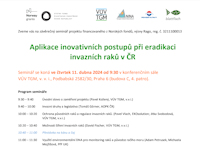
Invitation to the final seminars of the project
4 April 2024, České Budějovice and 11 April 2024, Prague (Czech Republic)
We invite you to the final seminars of the project “Use of innovative methods in the eradication of invasive crayfish in the Czech Republic”.
The seminars will be held on 4 April 2024 (České Budějovice) and 11 April 2024 (Prague).
The program and other details can be found in the attached invitations.
If you are interested in attending the seminar, please complete the
registration form by Monday 3 March 2024.
The capacity of the hall is limited. For any questions, please contact e-mail:
anna.antonova@vuv.cz
The program of both seminars is similar. Choose the seminar that suits you best in terms of date and place.
At the seminar in České Budějovice, a little more emphasis will be placed on contributions about Krvavý and Kačležský pond SAC and Horní Malše SAC.
Only here will also be a lecture by Austrian colleagues about the invasive signal crayfish.
In Prague, on the other hand, colleague Stein I. Johnsen from Norway will share his experience with the regulation of signal crayfish and the fight against crayfish plague. We will try to provide a translation for the lectures and the subsequent discussion with our foreign guests.
Invitation to a seminar in České budějovice: pdf document (602 kB, Czech)
Invitation to a seminar in Prague: pdf document (601 kB, Czech)
Localities
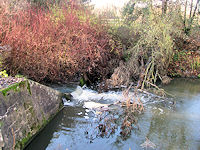
Zákolanský stream SAC
This is a site with the critically endangered stone crayfish (Austropotamobius torrentium), which is threatened by the invasive spinycheek crayfish (Faxonius limosus). The latter occurs in the Vltava, into which the Zákolanský stream flows.
The immunity rate of these crayfish by the dangerous crayfish plague is approximately 80%. The meeting of these two species could cause the crayfish plague to spread throughout the SAC and wipe out most of the stone crayfish population.
For these reasons, it is necessary to prevent the spread of invasive crayfish and prevent the spread of crayfish plague upstream towards the SAC.
Locality events
Aktuality pro lokalitu
20 December 2023
In the section of Zákolanský stream between Zákolanský potok SAC and the mouth of the Vltava, monitoring continued of the current state of crayfish occurrence and preparation for the installation of migration barriers.
On 20th June 2023, environmental DNA was sampled on three profiles (Zákolany/Otvovice above the step, above the confluence with Knovízský stream, at the confluence with the Vltava).
The samples are still being processed by the subcontractor (Faculty of Science, Charles University).
Povodí Vltavy, State Enterprise selected a contractor (Traton s.r.o.) and obtained all necessary permits for the modification of both migration barriers. Construction work began in October with a survey of the section
of Zákolanský stream between the modified step and the confluence with Dřetovický stream. 41 stone crayfish individuals were found in the gravel-stone alluvium below the stilling basin of the step.
The crayfish were relocated higher up in a suitable section of the riverbed. The purpose of both barriers was the addition of an overhanging barrier to the existing steps on the stream. The first
of them is located above the aforementioned confluence with Dřetovický stream (50.18314N, 14.24807E), the second is located lower down, between the villages of Zákolany and Otvovice (50.20297N, 14.25639E).
The barriers should prevent the upstream migration of non-native crayfish, but also prevent the return of stone crayfish that would encounter spiny-cheek crayfish infected with crayfish plague.
In addition to the spillway, the adjacent walls of the stilling basin were also secured. In both cases, the measures taken will protect the stone crayfish population living on the top part from crayfish plague.
An article was written about the implemented measure, which was published on the websites of local municipalities (Zákolany, Svrkyně). A meeting with residents, where the modification of both steps was presented,
took place in the spring. Another article was also written for the Povodí Vltavy newsletter. Placement of information signs near both migration barriers is under discussion with the municipality of Zákolany
and Povodí Vltavy, State Enterprise.
Photo gallery: hide photo gallery
Preview size: ⚫⚪⚪
More events
▼
8 February 2023
The technical details of the construction of barriers against the migration of invasive crayfish on the two existing steps at the bottom of Zákolanský stream bed has been agreed. Implementation is expected in the spring months of 2023.
During the summer months, environmental DNA (eDNA) samples were collected in Zákolanský stream. In Zákolanský stream, very weak signs were recorded with the stone crayfish probe. In this stream, the occurrence of a fairly stable population
of stone crayfish is confirmed about 3 km above the eDNA sampling location, so it is probable that the weak sign is from this population. Samples were taken in several places up to the confluence with Knovízský stream. No samples contained
spinycheek crayfish DNA. Further sampling will be carried out above the confluence of Zákolanský stream and the Vltava.
Photo gallery: hide photo gallery
Preview size: ⚫⚪⚪
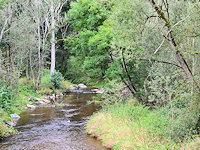
Horní Malše SAC
The stream contains the critically endangered freshwater pearl mussel (Margaritifera margaritifera) and green snaketail dragonfly (Ophiogomphus cecilia), with occurrence of noble crayfish (Astacus astacus) also recorded in the basin.
All of these species are threatened by the presence of signal crayfish (Pacifastacus leniusculus) in the stream, both by heavy predation and high crayfish plague (Aphanomyces astaci) immunity rate of signal crayfish. In the case of pearl mussel
and invasive crayfish in the stream, it is not possible to completely eradicate the crayfish, it is only possible to regulate the population and thus limit their migration within the stream to the sites where the pearl mussel is found.
Locality events
20 December 2023
Since the summer of 2022, the population of the invasive signal crayfish has been continuously reduced in Horní Malše SAC by manual trapping and catching in bait traps. Signal crayfish are being caught in the Malše border stream
in the section between Cetviny and the Mardesbach tributary.
In the period from 1/6/2023 to 19/9/2023, 5 trips took place, during which 40 bait traps were laid each time. A total of 548 signal crayfish were caught in bait traps, and 95 signal crayfish were caught during two manual catches.
At the beginning of June, when the water level was high and the temperature was low, the success in catching crayfish was very low. The greatest success was achieved by catching in bait traps between July (CPUE = 4)
and August (CPUE = 4 or 5.25 individuals per one bait trap).
Most crayfish were found around the ponds (48.61435N, 14.53224E). Above the ponds, the CPUE reached 7.8; below the ponds, the CPUE was 6.8. Crayfish catches have confirmed that crayfish have also moved further downstream.
In the section above Maltschstrasse no. 18 (48.61615N, 14.52124E) in August 2017, we caught only 1 crayfish from 3 bait traps (CPUE = 0.33). In 2023, there were already 46 crayfish from 6 bait traps (CPUE = 7.7).
Similarly, no crayfish were caught below the mouth of the Mardesbach tributary in 2017, while 12 crayfish were caught in 10 bait traps in August 2023 (CPUE = 1.2).
Catches were carried out in cooperation with a partner from Austria (blattfisch e.U.), who provided data on the distribution of signal crayfish in the Austrian part of the basin and communicated with local residents
and fishing right owners. For distribution and use in educational activities, we handed over some copies of the project calendars and the "Domestic vs. invasive crayfish in the Czech Republic" leaflet.
Photo gallery: hide photo gallery
Preview size: ⚫⚪⚪
More events
▼
8 February 2023
Catches of signal crayfish in Horní Malše SAC with freshwater pearl mussel (
Margaritifera margaritifera) took place on three dates in 2022. The first catch was carried out with a manual search of the refuges and was supplemented by bait
capture. Due to the higher water level (flow in Kaplice: 1.6 m
3/s) only 19 crayfish were caught (within 1.5 hours, 2 people). On 21
st September 2022, another catch of invasive crayfish was carried out, but at this time the flows were
even higher (flow in Kaplice: 2.4 m
3/s) and the water temperature was only 9 °C. Forty bow-nets were used, in which only 7 crayfish were caught and 14 crayfish were caught by hand on bait (4 people, about 2 hours). At a lower water
level (flow in Kaplice: 1.44 m
3/s) and warmer weather, 52 signal crayfish were caught in 40 bow-nets on 12
th October 2022. Most of the crayfish were found around the ponds (48.61435N, 14.53224E) and the lowest catch of crayfish was
below the mouth of the Mardesbach stream, above the village of Leopoldschlag.
Photo gallery: hide photo gallery
Preview size: ⚫⚪⚪
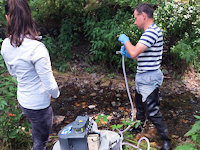
Stroupínský potok SAC
In 2018, stone crayfish and noble crayfish were exterminated at this site by crayfish plague. Surveys using environmental DNA indicated the occurrence of invasive red swamp crayfish in Kublovský (Pařezový) stream, which is a tributary of Stroupínský stream.
At the time of the survey, the presence of stone crayfish was proven, as well as the DNA of Aphanomyces astaci. The survey must be repeated to verify the presence of crayfish and crayfish plague.
Locality events
20 December 2023
The activities carried out at Stroupínský potok SAC focused on monitoring the simultaneous occurrence of invasive and native crayfish species. At the beginning of the summer, environmental DNA sampling was carried out at the SAC,
accompanied by a classic manual search of refugia. No crayfish individuals were found in any of the streams (Bzovský, Kublovský, Stroupínský). However, based on information from local residents about recent occurrence of crayfish
in Bzovský stream at the site of the recreational area, the existence of a refugium higher up in the basin can be expected.
Photo gallery: hide photo gallery
Preview size: ⚫⚪⚪
More events
▼
8 February 2023
In Stroupínský potok SAC, the occurrence of invasive crayfish and native stone crayfish was verified in 2022. Hand searches of refuges and eDNA sampling were conducted. No crayfish were found using the hand search.
Further monitoring took place in the summer months using environmental DNA (eDNA). The samples did not confirm the occurrence of invasive or native crayfish, nor the occurrence of crayfish plague (Aphanomyces astaci). Very weak signs were recorded with the
stone crayfish probe in Kublovský stream. From the results, it cannot be confirmed with certainty that the stone crayfish still occurs in Kublovský stream. This will be verified in the spring and autumn of 2023.
Photo gallery: hide photo gallery
Preview size: ⚫⚪⚪
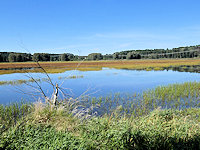
Krvavý and Kačležský pond SAC
The object of protection on the ponds is the loach (Cobitis sp.), which spends all its life at the bottom, where it burrows into the substrate. The occurrence of signal crayfish was detected at the site, which also seeks shelter near the bottom.
Competition is mainly manifested between species with overlapping ecological niches, so it is clear that the signal crayfish is primarily a competitor of smaller benthic fish species, with which it competes for food, for suitable shelters, and, simultaneously,
shares the same predators. Noble crayfish was also found in the tributaries in the past, but in recent years it has not been confirmed in most places. It was probably exterminated by crayfish plague, which was confirmed in signal crayfish.
Locality events
20 December 2023
During the field work, temporary information signs were installed at the sites. Great emphasis was placed on informing the public before Kačležský pond was fished. This is the period when the lay public can easily find crayfish on the exposed pond bottom.
With an information campaign, we drew attention to the danger arising from the spread of invasive crayfish. The signs were placed not only in the area of the dam, but also on notice boards of the surrounding municipalities
and settlements (Horní Pěna, Číměř, Kunějov, Člunek, Kunžak).
Information signs were also added in the section of experimental works on the Besének watercourse and on the Zákolanský stream in places where the steps were adjusted.
Photo gallery: hide photo gallery
Preview size: ⚫⚪⚪
More events
▼
8 February 2023
From 2
nd to 6
th August 2022, regulation of invasive signal crayfish was carried out in Kačležský pond. Crayfish were caught in bow-nets. Twenty bow-nets were used, which were collected after 2 to 26 hours at different times of the day.
A total of 170 bow-net collections were made and 945 signal crayfish were caught. The catch started at the time when supplementary fish feeding had stopped. The total number of crayfish per bow-net (CPUE) is 5.6, which is a very high population density.
Recommended criteria for evaluating population density (according to Johnsen, S.I., online):
C/TN (Number of crayfish / Number of bow-nets):
C/TN < 0.5: very low population density
0.5 < C/TN < 2.5: low to medium population density
2.5 < C/TN < 5: high population density
C/TN > 5: very high population density
Photo gallery: hide photo gallery
Preview size: ⚫⚪⚪
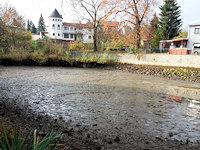
Prostřední pond
Prostřední pond in Dolní Chabry is one of the sites with occurrence of marbled crayfish (Procambarus fallax F. virginalis). The marbled crayfish is a crayfish species that can reproduce parthenogenetically and, as was proven at the site, they can give birth
to offspring several times a year, even in the winter months. This was the reason for an abundant crayfish population in Prostřední pond, which, due to the high population density, escaped into the adjacent stream. It is therefore probable that, without further
intervention, the escaped marbled crayfish will establish a new population.
Locality events
20 December 2023
At Prostřední pond in Prague - Dolní Chabry, monitoring continued of the attempt eradication of marbled crayfish. Approximately every month, the laying of bait traps was repeated combined with surveying with a dip net.
In June 2023, a small population of marbled crayfish was confirmed by the discovery of one individual about 3 cm in size. However, the population remains small; no crayfish have been caught in the bait traps. Even eDNA sampling
in the pond and the adjacent Drahanský stream and water bodies in the vicinity did not reveal the presence of marbled crayfish. Thus, its population was probably isolated to Prostřední pond and is now limited by stocked fish predation.
The manager of the pond, Prague City Hall, has desisted from further fishing for the time being.
Photo gallery: hide photo gallery
Preview size: ⚫⚪⚪
More events
▼
8 February 2023
During preparation of the project in 2021, more than 415 marbled crayfish were caught in Prostřední pond. The drained pond was limed and dried over winter. In 2021, marbled crayfish were caught in bow-nets again, so the pond was drained again and
crayfish were collected (a total of 65 individuals). Due to the fact that the crayfish started to dig burrows in which they survived even the dry season, a solution of milk of lime was used, which penetrates the burrows better. The pond was dried
over winter and dredged in the spring. Environmental DNA samples were taken from Drahanský stream and adjacent ponds. After filling the pond in the spring of 2022, the crayfish catch was repeated several times with the help of bow-nets and no
crayfish were detected. However, during the autumn survey of the bank areas, a fresh young crayfish (about 1.5 cm – i.e., this year's crayfish) was caught using a landing net. Perches must be released in the pond and the location will be carefully
monitored. Bow-nets will be used to catch larger crayfish. It is necessary to catch small crayfish and young crayfish with a landing net and control them by releasing fish predators. Monitoring and regulation of marbled crayfish in Prostřední pond
takes place in cooperation with the Prague City Hall.
Photo gallery: hide photo gallery
Preview size: ⚫⚪⚪
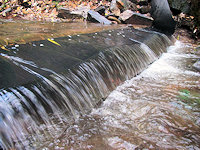
Besének
Besének is a stream in the Svratka basin, in which there was an abundant noble crayfish population until 2008. In that year, however, the native crayfish were exterminated by crayfish plague. In recent years, signal crayfish has started to spread upstream here.
In 2019, the occurrence of noble crayfish was again recorded in the upper part of the stream, which will soon be threatened by signal crayfish gradually spreading upstream.
Locality events
20 December 2023
At the Besének site, activities focused on assessing the success of the installed migration barriers in preventing the progress of signal crayfish upstream.
From May to October 2023, a total of 5 trips to the site were made, during which 977 signal crayfish individuals were caught, marked, and released back. In the second half of the year, only catches without marking were carried out (the crayfish
were then removed from the site and killed by freezing), during which 2,513 individuals were caught (both by hand fishing and by catching in bait traps), of which 317 were marked.
Together with 1069 individuals marked in 2022, a total of 2046 crayfish were marked and returned to the stream in both years. Total number of crayfish caught was 4,559.
Recapture results unfortunately still indicate a very strong population. At the same time, it was proven that the installed barriers on the steps are not 100% insurmountable for crayfish. The effect of obstacles on reducing upstream migration will
be evaluated in the coming months.
The experimental work was supplemented by a survey of the occurrence of invasive signal crayfish and native crayfish in the basin. Unfortunately, at the end of May the occurrence of signal crayfish was proven in the vicinity of the highest barrier
in Dolní Žleby. Two signal crayfish individuals were found just above the step. An interesting result was the discovery of a larger number of noble crayfish individuals in the vicinity of the step (8 individuals below the step, 2 individuals above the step).
The populations of both crayfish species are therefore in contact there. The occurrence of both species here was also confirmed by the results of the May and October eDNA sampling.
At the site of experimental work, information signs were installed and we distributed the remaining "Crayfish 2023" calendars and "Domestic vs. invasive crayfish in the Czech Republic" leaflets to the locals.
Photo gallery: hide photo gallery
Preview size: ⚫⚪⚪
More events
▼
8 February 2023
During the preparation of the project in 2021, an abundant population of invasive signal crayfish was confirmed in Besének stream near the settlement of Chrastová. At the same time, occurrence of noble crayfish was confirmed
upstream near the settlement of Dolní Žleby. In 2022, the work focused on a more precise localization of occurrence of signal crayfish and on implementation of measures against its spread higher up into the Besének basin.
During the summer of 2022, an abundant population of signal crayfish was detected by hand fishing at the height of the cottage settlement above the confluence with the Chrastová stream. Higher towards the confluence with the Kozárovský
stream, the population decreased and no signal crayfish was found below Dolní Žleby. Later analysed eDNA samples showed occurrence of signal crayfish in the entire monitored section, albeit with decreasing intensity upstream.
In order to limit migration higher up into Besének basin, the three existing steps were modified on the stream between the aforementioned cottage settlement and Dolní Žleby. Using a plastic board, an overhanging overflow edge was created
with a freely falling jet of water, and the adjoining bank was also equipped with a plastic barrier limiting the migration of crayfish on land. In the autumn before the described modifications were made, a study was carried out which,
using crayfish markings with coloured elastomers, proved that the steps were not a major migration obstacle for crayfish. In 2023, the study will be repeated to determine to what extent upstream migration of invasive crayfish has been reduced.
eDNA
Environmental DNA (eDNA) is genetic information released from an individual into the environment. In the aquatic environment in particular, the amount of detectable DNA is in many cases sufficient to confirm or refute the presence of the organism in question.
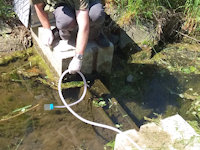
eDNA
8 February 2023, Prague (Czech Republic)
Environmental DNA (eDNA) sampling began in May 2022. The first sampling took place in Prague – at Dolní Chabry on Drahanský stream, which feeds Prostřední
pond (which has an occurrence of marbled crayfish). Samples were also taken from other ponds in Dolní Chabry. Sampling continued in the summer months in Stroupínský
and Zákolanský streams as well as Besének stream. The results confirmed the occurrence of signal and noble crayfish in the entire monitored section of the Besének.
The other samples were negative, in all cases also for crayfish plague. On the Zákolanský and Kublovský streams, very weak signs were recorded with the stone crayfish probe. From the results,
it cannot be confirmed with certainty that stone crayfish still occurs in Kublovský stream. This will be verified in the spring and autumn of 2023. In Zákolanský stream, the occurrence
of stone crayfish has been verified about 3 km above the site of eDNA sampling.
Lectures
Prevention associated with informing about the harmfulness of invasive species is always many times cheaper than dealing with subsequent problems with their spread. Educating the professional and lay public is a way to at
least partially prevent the deliberate spread of invasive species in the wild.

Lecture on invasive crayfish in Lednice
19 September 2023, Lednice (Czech Republic)
On 19
th September 2023, a lecture on invasive crayfish was held at Autocamp Apollo near Lednice, with a practical demonstration of signal crayfish and a subsequent discussion and tasting for students from Gymnázium Arabská,
who were attending a natural science field trip there. The lecturer was Mgr. Vojtěch Macháček.
Photo gallery: hide photo gallery
Preview size: ⚫⚪⚪
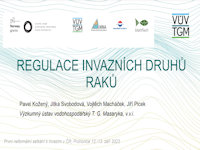
Participating in an ”Invasion meeting“
12 September 2023 - 13 September 2023, Průhonice (Czech Republic)
On 12
th and 13
th September 2023, we participated in the First Informal Meeting on Invasions in the Czech Republic. The meeting was attended by representatives of organizations associated with biological
invasions in the Czech Republic – Academy of Sciences institutes, universities, ministry research organizations (MoE and MoA), Povodí Vltavy and Povodí Labe State Enterprises – as well as representatives of regional
authorities and non-governmental organizations. The aim of the meeting was to inform each other about invasive species of animals, plants, and pathogens in different types of environments, as well as ongoing research
and regulatory projects, methods of managing invasive species, and mitigating their negative impact on wildlife and human society. Emphasis was also placed on cooperation between research organizations and state administration.
The participants agreed to establish a joint platform that will serve for closer cooperation, mutual awareness, and regular meetings.
On behalf of TGM WRI, a lecture entitled "Regulation of invasive species of crayfish" was presented at the meeting. The purpose of the lecture was to acquaint participants with our results and experience in the field
of methods of regulation of invasive species of crayfish in the Czech Republic. During the lecture, we also distributed information leaflets and calendars.
Presentation: dokument pdf (3.0 MB)
Abstract: dokument pdf (229 kB)
Proceedings: external link (Czech)
Press release: external link (Czech)

Lecture at a summer camp at Kačležský pond
1 August 2023, Kačležský pond
On 1
st August 2023, a lecture on the occurrence of invasive signal crayfish was held for participants of a children's camp at Kačležský pond. 30 children and 8 camp leaders participated in the lecture.
We also gave out the calendars as well as "Domestic vs. invasive crayfish" leaflets.
Photo gallery: hide photo gallery
Preview size: ⚫⚪⚪

TGM WRI Open Day
21.6.2023, Prague (Czech Republic)
As part of the TGM WRI Open Day in Prague, the issue of non-native species was presented with a focus on regulating invasive species and protecting domestic crayfish species. The event was attended by more than 100 children from Prague
primary schools and the lay public. The latest Crayfish in the Czech Republic calendars were distributed, as well as new "Domestic vs. invasive crayfish in the Czech Republic" leaflets.
Additional information: external link (Czech)
Photo gallery: hide photo gallery
Preview size: ⚫⚪⚪
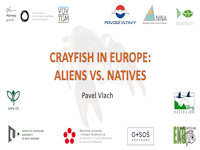
Lecture at Eskola Secundaria Homeme Cristos in Aveiro
19 April 2023, Aveiro (Portugal)
On 19
th April 2023, a lecture on the impact of invasive crayfish on the ecosystem and an identification workshop was held in Portugal for 80 students of Eskola Secundaria Homeme Cristos in Aveiro. The lecturer was RNDr. Pavel Vlach, Ph.D.
Presentation: pdf document (13.6 MB)

Lecture at the municipal office in Zákolany
27 March 2023, Zákolany (Czech Republic)
On 27
th March 2023, a lecture was held at the municipal office in Zákolany with the participation of the municipality board and local residents. The speakers were Jitka Svobodová, Pavel Kožený, and Vojtěch Macháček.
There was a discussion about the problems with water quality in the stream in connection with the construction of a WWTP in the basin. Also, there was a presentation of the mobile application “Crayfish in the Czech Republic”,
as well as the modifications to the river bed drops of Zákolanský stream, which will prevent the spread of spiny-cheek crayfish.
Presentation - EVL Zákolanský potok a mobilní aplikace „Raci v ČR“ (J. Svobodová): pdf document (3.0 MB, Czech)
Presentation - Regulace populací a šíření invazních druhů raků (P. Kožený): pdf document (2.8 MB, Czech)

Czech Anglers Union
26 January 2023, Prague (Czech Republic)
On 26
th January 2023, there was a presentation at the Department of Environment and Water Purity at the Czech Anglers Union Council on topics related to the protection of native crayfish and the
regulation of non-native crayfish. The lecturers were Jitka Svobodová and David Fischer.
Attendance list: pdf document (258 kB, Czech)
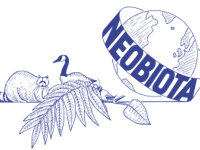
12th International Conference on Biological Invasions
12 September 2022 - 16 September 2022, Tartu (Estonia)
In September 2022, the 12th International Conference on Biological Invasions took place in Tartu, Estonia, focusing on "Biological Invasions in a Changing World". At the conference,
the progress of the regulation of invasive marbled crayfish in the Prostřední pond in Dolní Chabry in Prague was presented in the form of a poster (Hard to deal with: attempts for
eradication of marbled crayfish from a small urban pond).
Poster: pdf document (5.1 MB)
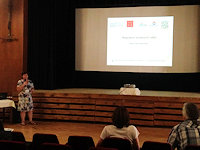
Limnological conference
30 June 2022 - 24 June 2022, Bratislava (Slovakia)
From 20
th to 24
th June 2022, an international limnological conference took place in Bratislava. The topic of "Regulation of invasive crayfish" was presented at the conference.
Our lecture was focused on legislation regarding invasive species, with a focus on invasive crayfish. Various methods of regulating invasive crayfish were presented, which will be used in
the project "Application of innovative procedures in the eradication of invasive crayfish in the Czech Republic" financed by Norwegian Funds, RAGO call. The regulation methods can be found in
the "Methodology for the regulation and eradication of invasive species of crayfish: selection of suitable methods depending on the nature of the water body", which was created in the project of
the Technological Agency of the Czech Republic TH02030687 "Prediction of the danger of non-native fish and crayfish and optimization of eradication methods of invasive species".
One of the other outputs of the project, which were also presented at the conference, was the mobile application "Crayfish in the Czech Republic" (available on Google Play), which can
be used to determine crayfish species and send a record
of their occurrence.
Presentation: pdf document (4.5 MB, Czech)
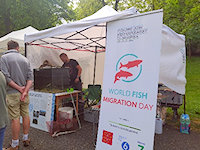
Thematic program on the occasion of World Fish Migration Day
17 May 2022 - 18 May 2022, Prague (Czech Republic)
On the occasion of World Fish Migration Day (WFMD), it took place on 17. and 18. May a two-day thematic program aimed at raising general
awareness of water fauna and flora on the principles on which aquatic ecosystems operate, including the issue of the quality of the environment in which aquatic organisms must live.
The program also included information on autochthonous and allochthonous crayfish and their spread and danger to native fauna and flora.
Invitation: pdf document (979 kB, Czech)
Information about the event: pdf document (732 kB, Czech)
World Fish Migration Day pages: external link
Articles
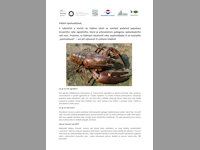
Informative articles
20 December 2023
We have added information about informational articles published during 2023 to the “Results” tab.
See “Results” tab
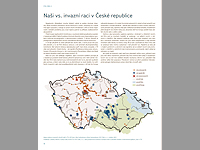
Article “Native versus invasive crayfish in the Czech Republic”
13 September 2023
The article “Native versus invasive crayfish in the Czech Republic” was published in number 4/2023 of the VTEI journal.
See “Results” tab
Other events

Joint monitoring of sites in Norway
4 September 2023 - 8 September 2023, Norway
Between 4th and 8th September 2023, a meeting of project managers from the Czech Republic and the Norwegian Institute for Nature Research (NINA) took place. Our Norwegian colleague, Stein I. Johnsen, prepared the programme
in the south-eastern part of Norway, where the noble crayfish, Norway's only native species of crayfish, is found. However, its population is threatened by the invasive signal crayfish, which was first detected in Norwegian
waters in 2006. During joint site monitoring, we were introduced to the fate of the crayfish populations on the Mysen and Billa rivers, the Halden channel and lake Harstadsjoen, which were affected by crayfish plague.
We had the opportunity to see simple measures against the spread of invasive crayfish, especially the adjustment of steps and culverts on streams. In Norway, regulation against invasive crayfish is not only a matter
of nature conservation, but also of economic interest for local residents, for whom catching and selling noble crayfish is a source of income. We had the opportunity to discuss the environmental DNA collection methods
and the interpretation of the results with D. Strand from the Veterinary Institute, who closely cooperates with NINA in monitoring. Thanks to a combination of traditional bait trap catching and numerous eDNA sampling,
the Norwegian colleagues are able to detect the progress of crayfish plague and propose measures against its spread in good time. At the end of the week, we caught several signal crayfish individuals together
on Lake Ostersjoen and thus proved its occurrence there. It was not a happy outcome, but according to Norwegian rules it was the first step to start a set of regulatory measures.
Photo gallery: hide photo gallery
Preview size: ⚫⚪⚪
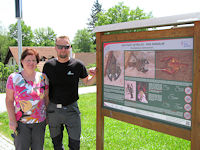
Visit of partner from Norway
29 May 2023 - 1 June 2023, localities with crayfish occurrence (Czech Republic)
From 29
th May until 1
st June 2023, we had a visit from project partner Stein Ivar Johnsen from the NINA organization in Norway.
On Monday, after our Norwegian colleague's arrival in Prague, we visited Karáskův stream in Křivoklátsko with an occurrence of the stone crayfish (Austropotamobius torrentium), from which we took environmental DNA (eDNA) samples.
The next visit was to Tyterský stream, where crayfish were introduced in 2020 from Bzovský stream, which was affected by crayfish plague in 2018. Manual monitoring has not yet found any crayfish, so eDNA was also collected from the stream.
During the sample collection, we introduced our colleague to our eDNA sampling equipment and discussed the methodology of the work and interpretation of the results.
On Tuesday 30th May 2023, there was a trip to the Besének, which is a tributary of the Svratka in the South Moravian region. The protected noble crayfish (Astacus astacus) is found in the upper part of this stream, and the invasive
signal crayfish (Pacifastacus leniusculus) spreads upstream towards Svratka. We introduced our Norwegian colleague to the system of migration barriers that we created during the project on the existing river bed drops against
the spread of invasive crayfish. Together we carried out monitoring during which noble crayfish were confirmed in the area of Dolní Žleby. Furthermore, there was an inspection of the installed migration barriers lower on the Besének
with a strong population of signal crayfish. From the Besének, we continued to Jindřichův Hradec via Telč.
On Wednesday 31st May 2023, we placed the bait traps in Kačležský pond with the occurrence of signal crayfish. We presented to our colleague the method of management in ponds and consulted on the usefulness of fish predation
in the regulation of invasive crayfish in these systems. This was followed by a visit to Chlum stream and verification of the presence of crayfish. A massive die-off of crayfish was recorded in this stream in 2021, with the suspected
influence of toxic metals leached from deforested areas.
On Thursday 1st June 1 2023, a visit to the Malše border section near the village of Leopoldschlag followed. In this SAC, there is a critically endangered freshwater pearl mussel (Margaritifera margaritifera), which is threatened
by the invasive signal crayfish. Here, the bait traps were collected and invasive crayfish were caught by hand. In the afternoon, we returned back to Prague.
On Friday 2nd June 2023, the bait traps were collected from Prostřední rybník in Dolní Chabry. No crayfish were caught in the bait traps, but the subsequent catch using a landing net confirmed the occurrence of marbled
crayfish (Procambarus fallax F. virginalis).
During the visit, we showed the partner most of the sites where we proceed according to the “Methodology for the regulation and eradication of invasive crayfish species: selection of appropriate methods depending on the nature of the water body”
within the RAGO Norwegian Funds project “Application of innovative procedures in the eradication of invasive crayfish in the Czech Republic”. At the same time, we gained valuable experience from the procedures used in regulating invasive crayfish in Norway.
Photo gallery: hide photo gallery
Preview size: ⚫⚪⚪
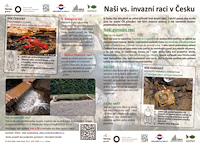
Leaflet “Native vs. invasive crayfish in Czech Republic”
31 May 2023, Prague (Czech Republic)
We have added a new leaflet “Native vs. invasive crayfish in Czech Republic” created in the project to the "Results" tab.
See: “Results” tab
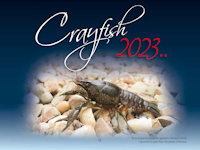
Calendar “Crayfish 2023”
24 February 2023, Prague (Czech Republic)
We have added a thematic calendar for the year 2023 created in the project to the "Results" tab.
See: “Results” tab

Website became available
24 August 2022, Prague (Czech Republic)
Web pages of the project were completed and made available on the internet. The pages will be updated during the project's period to include information about
the progress of the project and realization of planned outputs.

Project began
1 March 2022, Prague (Czech Republic)
The project was launched. Work started with the necessary preparatory and administrative activities.
Last update or revision: 10 April 2024


























